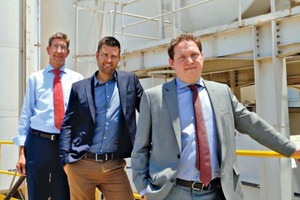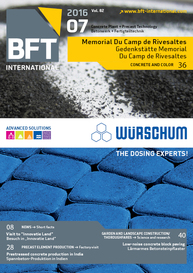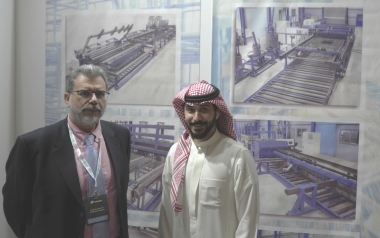Anniversary: From desert dream to reality
For a lot of people the United Arab Emirates are an embodiment of the superlative, economic boom and progress. In the 2000 s, there was a real run of foreign companies on the region. However, more than a few of them misjudge the challenges and circumstances of the market. And therefore, it cannot simply taken for granted that the subsidiary of an international corporation celebrates its 10th anniversary, like Ha-Be Middle East is doing now. Ulrich Meyer, Klaus Hofmann and Marcel Paulitsch talk about the expansion of the subsidiary, the peculiarities of the market in terms of concrete technology and the most impressing projects of the company in a conversation with Anne Sander, Marketing and Communications Manager at Ha-Be.
Sander: In 2006, Ha-Be Middle East FZE was founded as an affiliated company of Ha-Be Betonchemie GmbH & Co. KG. How does such a foundation take place?
Meyer: First of all, we had carried out a market research, and we had calculated the risks and chances. On the one hand, we saw the large potentials, but on the other hand, we were also faced with the discouraging terms of payment usually granted to the customers in the market and the associated liquidity required. At first, we came to the conclusion that we should rather refrain from the market. However, shortly after this decision, I got an inquiry from two Arabs, who found us on the internet and intended to cooperate with us. The two men had started to build a production facility and were looking for a partner, who was able to provide the technical input. As soon as we had all agreed that we could enter as partners with limited financial risk, we finally accepted.
Sander: How did you find the first employees?
Meyer: Björn Mordhorst was our “man of the first hour”. By the way, he is still working with Ha-Be and as General Manager and Sales Manager is now member of the management board in Germany.
In 2006, he was initially working with us and another company additionally. When the foundation of Ha-Be Middle East was completed, he luckily decided to work with us exclusively.
Sander: How many employees have Ha-Be Middle East at present?
Hofmann: For the time being, 40 employees from eight different nations are working with us.
Sander: What are the challenges if so many different nations are working together?
Hofmann: We have employees from Egypt, Bangladesh, Germany, India, Cameroon, Nepal, Pakistan and the Philippines. Basically, we communicate in English, which does not cause any problems.
However, all nations have different business standards, different conceptions of value and cultural particularities. Therefore, a high level of tolerance is required, when working in such a multicultural team, as well as sensitivity regarding different opinions and religious and cultural customs.
Sander: How do these cultural differences show up?
Paulitsch: It is hard to tell in general. Mostly the differences become obvious in special rituals and practices. An impressive experience was the Indian festival of lights called Diwali. I had the opportunity to see how all testing tools and devices were decorated at a concrete plant for this festival. The god of fortune and the goddess of wealth and prosperity are honored at this festival. And so they will not miss one‘s own company, it is lavishly decorated accordingly.
Sander: Now, you have been in the region for some time already. How would you describe the differences between the Arab and the German culture?
Hofmann: The Emiratis and the Arabs are very polite, warm-hearted and hospitable people. Here, it is very important to establish a personal relationship with potential business partners. In Germany the focus is on “problem and solution”. Such focusing is considered as aloof and reserved, with a negative effect. For this reason, the conclusion of a business transaction takes much longer than we are used in Germany.
Sander: And from a commercial point of view – what was your most impressing experience during your stay in the UAE?
Meyer: Perhaps it may sound unbelievably under European conditions, but quite in the early days we had concluded a delivery contract with the local market leader of ready-mix concrete, obligating ourselves to supply a monthly minimum quantity of 2,000 tons of concrete admixtures. Not only that this quantity is remarkable itself, but also a provision was agreed upon in the same contract, entitling us to a compensation of 20,000 euros per month if the purchase quantity is less than 500 tons per month.
This particular situation was due to the fact that there was a shortage of concrete admixtures owing to the construction boom at that time and every concrete manufacturer had tried to protect themselves in their own way. It's a pity that this extraordinary phase had been over two years later.
Sander: What was the most impressive project realized by Ha-Be Middle East in the last ten years?
Meyer: Even if it has been already some years ago, for me the construction of the Palm Island Jumeirah was the most imposing project during our time in the Middle East. The Palm Island was a giant prestigious project and has become a symbol for the entire region in the meantime.
It feels very good to be involved in such a project. At that time, we had delivered the first IBC containing our Pantarhit N (FM) superplasticizer by airfreight from Germany directly to the respective Palm Island. Everything had to be carried out very quickly and the freight charges certainly accounted for eight to ten times the product value. In the end, however, the investment paid off because after that we became the main supplier for the project.
Hofmann: For me, the two bridges – Sheikh Khalifa Bridge and Saadiyat Island Bridge – were the most impressive projects. As entrance gates to Abu Dhabi, they are not only important arterial roads, but also exceptional architectural structures because of their design.
Paulitsch: In my opinion, these were the three skyscrapers Dubai Pearl, Marina 1-0-1 and the ADNOC Headquarters. The Dubai Pearl building is a complex consisting of four towers which are horizontally connected to each other by a so-called "skywalk" at the top. Each of these four towers required an own foundation. The speed and the amounts of concrete needed were simply gigantic: 11,000 m³ were need for each of the foundations. They were produced and installed within 24 hours. The amounts needed were manufactures in six different factories, using more than 100 ready-mix trucks in total for transportation and 13 pumps for placing. Regarding the Marina 1-0-1 building and the ADNOC Headquarters, I am impressed by the architecture. Both high-rise buildings are distinguished by beautiful exceptional designs, perfectly fitting into the skyline of Dubai.
Sander: About the product portfolio: Now, you are manufacturing the concrete admixtures in the UAE locally. Is it possible to transfer the proven formulations from Germany to the Middle East or do you have to develop own products for the market region?
Paulitsch: We develop a large part of the products by ourselves locally. The main reason are the different conditions, to which the admixtures have to be adapted. The framework conditions in the Middle East are totally different from the ones in Germany. Starting with different cements to different aggregates through to the totally different weather conditions. Here the product must perform under extremely high ambient temperatures. This is different in Germany and we have to take it into account when selecting the respective raw materials of the admixture formulation.
Sander: The production of concrete is mostly governed by standard DIN EN 1045 in Germany. However, BS EN (British Standard European Norm), BS & ASTM (American Society for Testing and Materials) are primarily used in the Middle East. What are the effects of the different standardizations in practice?
Paulitsch: The Middle East uses other test methods than Germany. The slump flow is used instead of the slump, for example. In addition to that, in the Middle East the strategy to develop a concrete mix design is different to the approach in Europe. The planner or his consultant provide the specifications in the Middle East. He also develops the mix design according to which the concrete manufacturer has to produce. Whereas standards stipulate the requirements in Germany. And how to meet these requirements is the task of the concrete manufacturer with the collaboration of his suppliers.
Sander: Are there any differences in the way of manufacturing and processing concrete in the factory as well as on the construction site?
Hofmann: A big difference is the fact that the availability of raw materials for concrete completely differs from Germany. Except for cement in fact all raw materials must be imported or transported over long distances; quarry sites for excavating aggregates are limited to just some regions. Blast-furnace slag, fly ash, microsilica and steel fibers are not produced there. For this reason, the availability of raw materials is limited and the choice options are smaller. In Germany, there is a much wider range of raw materials available. The different raw materials allow for a higher flexibility.
Paulitsch: Another difference compared to Germany is the fact that PCE-based admixtures have been entering the market more widely only for the last few years. Many concrete manufacturers still use naphthalene- and lignine-based superplasticizers. Here an admixture has to be robust above all. A lot of producers have made good experience with the conventional superplasticizers; hence they do not want to change. However, the advantages of the PCE-based superplasticizers are more and more coming to the fore.
Sander: And what about the plant technology for concrete production – are there any differences compared to the production in Germany?
Paulitsch: The plant technology is absolutely comparable with that in Germany. Most machinery and equipment suppliers are international companies, operating in Germany as well as in the Middle East market region. Therefore, the technology is pretty much the same.
Sander: Some years ago, the economic crisis also reached Dubai. Was Ha-Be Middle East affected by the crisis?
Hofmann: Certainly. The economic crisis affected the construction industry significantly. Many projects were stopped, postponed or put on hold completely. This, of course, had an influence on the concrete quantities produced in the UAE, hence the sales volume of admixtures. The quantities manufactured by us were declining very, very much.
Sander: How is the present situation at Ha-Be Middle East?
Hofmann: For a good one and a half years now, the negative trend has reversed. From this point of time onwards, building projects have been continued and new ones were started. Therefore, more concrete is produced again and the demand for admixtures is increasing accordingly. However, we have also changed our strategic orientation over the last few years. Until then, our main business was the production of admixtures for ready-mix concrete. Now, we have extended our product range by admixtures for concrete products, liquid colors, surface protection systems and mircosilica, thus entering new market segments. Furthermore, we even more focus on offering special technologies and individual solutions.
Sander: What are your expectations for the future?
Hofmann: Basically, we want to achieve three goals in the next few years: At first, of course, we would like to keep and retain our present regular customers in the UAE and in Oman. For this purpose, we intend to further extend and strengthen the newly developed market segments, admixtures for concrete products, liquid colors, surface protection systems and microsilica as well as the special technologies.
Our third goal is to broaden our export business in the surrounding countries, such as India, Iran and the region of North Africa. We expect to develop new sales markets there together with our local partners.
Sander: But before you begin to achieve these goals, you will certainly celebrate your 10-year anniversary at first. What are your plans in this regard?
Hofmann: We will organize an internal event to celebrate with all staff members of the three locations in Sharjah, Oman and Qatar. Some of the employees in fact have been working with the company since the foundation. For this we are very grateful and would like to honor them particularly during the anniversary celebrations.



